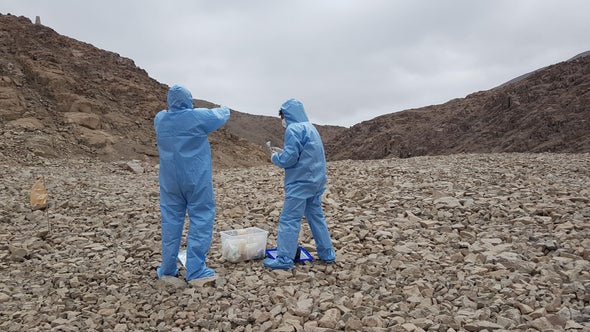(单词翻译:单击)
听力文本
This is Scientific American's 60-second Science, I'm Christopher Intagliata.
The Curiosity Rover was never fully sterilized before it touched down on Mars. And there's been debate whether the rover drill might contaminate certain subsurface areas thought to potentially harbor life. But it turns out the rover may not need to physically drive somewhere to pollute that spot with Earth's microbes. Because if there are any tiny earthlings on the rover, the strong winds on Mars might be able to spread them around the Red Planet instead.
"Wind storms are very common on Mars even on the planetary scale. So you have one point of contamination, and given the proper conditions, you could disperse whatever you were carrying there to distant places."
Armando Azua-Bustos, a research scientist at the Center for Astrobiology at the Superior Council of Scientific Research in Spain.

Azua-Bustos is now more certain that such spread might be possible because of an experiment his team carried out in Chile's Atacama Desert—the conditions of which make it a popular Mars analogue. There, his team placed petri dishes along two paths cutting from the coast into the driest parts of the Atacama. One path was 30 miles long; the other 40 miles long. They waited for winds to deliver coastal dust to the petri dishes. Then they grew whatever landed.
On both paths, they found a multitude of viable bacterial and fungal species, which suggests that microbes are indeed able to fly over the driest and most UV-blasted desert on Earth in just a matter of hours—and arrive unharmed. The details are in the journal Scientific Reports.
The researchers say wind could therefore be a way to easily contaminate another planet with Earth microbes if spacecraft aren't sterilized—or a way for Martian life in once-fertile areas to hitchhike to others by flying on dust in the wind.
Thanks for listening for Scientific American — 60-Second Science. I'm Christopher Intagliata.
参考译文
这里是科学美国人——60秒科学系列,我是克里斯托弗·因塔格里塔。
“好奇”号火星探测器在着陆火星前从未进行过彻底消毒。关于探测器勘探是否会污染某些被认为可能存在生命的地下区域,一直存在争议。但结果发现,探测器可能无需开到某个地方,用地球上的微生物污染那个地方。因为如果探测器上存在任何微小的地球生物,那火星上的强风可能会将它们传播到这颗红色星球的各个地方。
“在火星上,行星规模的风暴非常常见。因此,如果有一个污染点,那在适当条件下,你可以将你携带的任何东西扩散到遥远的地方。”
西班牙高等科学研究委员会天体生物学中心的研究科学家阿尔曼多·阿苏瓦-巴斯托斯说到。
阿苏瓦-巴斯托斯现在更加确定这种传播是可能的,因为他的团队在智利阿塔卡马沙漠进行了实验,该沙漠的条件与火星类似。在那里,他的团队从海岸线切出通往阿塔卡马沙漠最干旱地区的两条路,并沿两条路放置了培养皿。一条路长30英里,另一条路长40英里。他们等待风将沿海的尘土吹到培养皿里。之后他们会把任何落下来的东西都种起来。
他们在两条路上都发现了大量可存活的细菌和真菌,这表明微生物确实能在几小时内飞越地球上最干旱、紫外线照射最强烈的沙漠,而且毫发无损地到达。研究详情发表在《科学报告》期刊上。
研究人员表示,如果宇宙飞船没有消毒,风可以轻松地用地球上的微生物污染另一颗行星,或是让火星上曾经富饶地区的生命搭便车去其他地方,乘着风中的尘土飞扬。
谢谢大家收听科学美国人——60秒科学。我是克里斯托弗·因塔利亚塔。
译文为可可英语翻译,未经授权请勿转载!
重点讲解
重点讲解:
1. touch down 降落;着陆;
Spacecraft Columbia touched down yesterday.
“哥伦比亚”号宇宙飞船昨天着陆。
2. turn out 结果发现;
Cosgrave's forecast turned out to be quite wrong.
科斯格雷夫的预测最后证明是大错特错。
3. because of 因为;由于;
Many families break up because of a lack of money.
许多家庭由于缺钱而破裂。
4. carry out 实施;执行;实行;
Frank was carrying out fuel-system tests which necessitated turning the booster pumps off.
弗兰克在做燃料系统测试,这一测试需要关掉升压泵。


